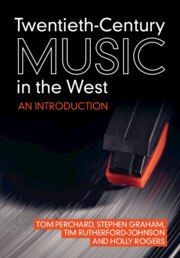Book contents
- Twentieth-Century Music in the West
- Twentieth-Century Music in the West
- Copyright page
- Contents
- Figures
- Tables
- Acknowledgements
- Introduction
- Part I Histories
- Part II Techniques and Technologies
- Part III Mediation
- 9 Recording and Production
- 10 Copyright and the Music Industry
- 11 States and Markets
- 12 Music and the Moving Image
- Part IV Identities
- Bibliography
- Index
10 - Copyright and the Music Industry
from Part III - Mediation
Published online by Cambridge University Press: 15 September 2022
- Twentieth-Century Music in the West
- Twentieth-Century Music in the West
- Copyright page
- Contents
- Figures
- Tables
- Acknowledgements
- Introduction
- Part I Histories
- Part II Techniques and Technologies
- Part III Mediation
- 9 Recording and Production
- 10 Copyright and the Music Industry
- 11 States and Markets
- 12 Music and the Moving Image
- Part IV Identities
- Bibliography
- Index
Summary
Is music property? If so, can it be owned – and by whom? Can it be stolen? Who gets to make money from it – and who risks being exploited? Answers to these questions all hinge on the issue of copyright: the legal instrument that defines the owner of a musical work and gives them exclusive rights to make copies of it. Copyright may seem like a marginal, even bureaucratic subject for a music textbook. Yet it is central to the history of music in the twentieth century. Without copyright, music publishing – and therefore a music industry – is almost unimaginable (Frith and Marshall 2004: 1). And copyright is the framework through which music in the twentieth century was understood legally and economically – and, consequently, morally.
- Type
- Chapter
- Information
- Twentieth-Century Music in the WestAn Introduction, pp. 253 - 270Publisher: Cambridge University PressPrint publication year: 2022

